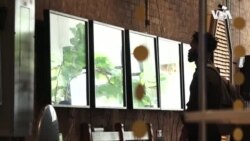ນັບແຕ່ໂທລະສັບມືຖືສະຫຼາດຈົນຮອດປ້າຍໂຄສະນາ, ຈໍສະແດງພາບດິຈິຕອລແມ່ນມີຢູ່ທົ່ວທຸກຫົນທຸກແຫ່ງ. ແຕ່ບາງບໍລິສັດເວົ້າວ່າຈໍສະແດງພາບທີ່ດີທີ່ສຸດແມ່ນຕາຂອງມະນຸດເອງ, ແລະພວກເຂົາເຈົ້າກໍາລັງພັດທະນາຄອນແທກເລນ ຫລືເລນໃສ່ຕາສະຫລາດບາງຢ່າງ ຊຶ່ງເປັນຄວາມຮູ້ໃໝ່ຂຶ້ນມາ. Tina Trinh ມີລາຍງານກ່ຽວກັບເລື້ອງນີ້ ຊຶ່ງບົວສະຫວັນ ມີລາຍລະອຽດ ມາ ສະເໜີທ່ານ ໃນອັນດັບຕໍ່ໄປ.
ພວກເຮົາຫາຂໍ້ມູນຈາກໜ້າຈໍທຸກມື້ ແຕ່ມັນຈະເປັນແນວໃດຖ້າຫາກວ່າ ປະສົບການນັ້ນສາມາດຖືກສົ່ງໄປຫາຕາຂອງທ່ານໂດຍກົງເລີຍ?
ນັ້ນແມ່ນສິ່ງທີ່ບໍລິສັດຈໍານວນນຶ່ງຫວັງວ່າຈະປະສົບຜົນສໍາເລັດໄດ້ ດ້ວຍການໃຊ້ ຄອນແທັກເລນ ຫລືເລນໃສ່ຕາແບບສະຫລາດ - ຊຶ່ງເປັນເລນທີ່ຢູ່ໃນຂອບເຂດສາຍຕາຂອງຜູ້ໃຊ້ນັ້ນ ມີຂໍ້ມູນທາງດີຈີຕອລລວາງຊ້ອນກັນໄວ້.
ທ່ານ ໄມໂຄ ເຮສ໌ (Michael Hayes), ຫົວໜ້າຜູ້ບໍລິຫານ ຫລື CEO ຂອງບໍ ລິສັດ ອິນວິດ (InWith), ກ່າວຜ່ານທາງ Skype:
"ເຈົ້າສາມາດຍ່າງໄປມາໂດຍທີ່ເອົາພາບສະແດງໄວ້ຢູ່ໃນຕາຂອງທ່ານຕະຫລອດ 24 ຊົ່ວໂມງໃນ 7 ມື້ເລີຍ."
ມັນອາດຈະເບິ່ງຄືວ່າ ເປັນແນວຄວາມຄິດທີ່ໄກຈາກຄວາມຈິງຫລາຍ, ແຕ່ບັນດານັກວິສະວະກອນໃນບໍລິສັດເລີ່ມຕົ້ນກໍ່ຕັ້ງໃໝ່ໄດ້ພາກັນພັດທະນາເລນໃສ່ຕາສະຫຼາດທີ່ເຂົ້າກັບລະບົບສິ່ງເປັນຈິງແບບຮອບຮູ້ຂອງຄອນແທັກເລນທີ່ໃຊ້ປະຈໍາວັນນັ້ນ.
ທ່ານ. ໄມໂຄ ເຮສ໌ ຈາກບໍລິສັດອິນວິດ (InWith) ເຊິ່ງໄດ້ສ້າງຕົ້ນແບບໂດຍໃຊ້ເລນ ບາວສ໌ (Bausch) ແລະ ເລນໂລມບ໌ (Lomb) ກ່າວຜ່ານທາງ Skype ວ່າ:
"ພວກເຮົາເລີ່ມຈາກຄວາມປອດໄພ ແລະປະສິດທິພາບຂອງຄອນແທກເລນ ຄື ກັນກັບຕອນນີ້ແລະ ...…ຈາກນັ້ນ ພວກເຮົາກໍໄດ້ຄົ້ນພົບ ວິທີການລວມເອົາວົງຈອນນັ້ນ ເຂົ້າໄປຝັງຢູ່ໃນເລນປະເພດເຫລົ່ານັ້ນ.”
ຜູ້ຜະລິດຄອນແທັກເລນສະຫລາດເວົ້າວ່າ ຮູບລັກສະນະທີ່ຮອບຄອບຂອງມັນ ເປັນສິ່ງດຶງດູດໃຈຕົ້ນຕໍ.
ທ່ານ ເຮສ໌ ກ່າວຜ່ານທາງ Skype ອີກວ່າ:
"ບໍ່ມີປັດໄຈ 'ທີ່ບໍ່ເປັນປະໂຫຍດ' ຢູ່ໃນມັນເລີຍ...ເມື່ອແຫວ່ນຕາກູໂກ ຫລື Google Glass ອອກມາສອງສາມປີກ່ອນ, ຜູ້ຄົນບໍ່ ຢາກຍອມເອົາມັນມາໃຊ້ ຖ້າຈະເວົ້າໃນຄວາມເປັນຈິງກໍຄືຍ້ອນເລື້ອງຂອງຄວາມ ສວຍງາມ."
ໃນຂະນະທີ່ບໍລິສັດ InWith ເຮັດວຽກກັບຄອນແທັກເລນທີ່ອ່ອນ, ບໍລິສັດອື່ນແມ່ນໃຊ້ເລນລະດັບການແພດທີ່ແຂງກວ່າ.
ທ່ານ ສຕີບ ຊິນແຄລ (Steve Sinclair) ຈາກບໍລິສັດໂມໂຈ ວີເຊີນ (Mojo Vision) ກ່າວວ່າ ເລນຂອງໂມໂຈ (Mojo) ທີ່ອອກແບບໃຫ້ເໝາະກັບຄວາມ ຕ້ອງການຂອງລູກຄ້າລ້ວນແລ້ວແຕ່ແມ່ນກ່ຽວກັບການຄໍານວນແບບເບິ່ງບໍ່ເຫັນ ທັງນັ້ນ.
ທ່ານກ່າວຕໍ່ໄປວ່າ:
"ພວກເຮົາຄວນຈະສາມາດເອົາຂໍ້ມູນທີ່ພວກເຮົາຢາກໄດ້ໃນຕອນທີ່ພວກເຮົາຢາກ ໄດ້ມັນ, ພ້ອມດຽວກັນນັ້ນ ກໍຍັງມີການພົວພັນກັບໂລກຕົວຈິງນຳອີກຢູ່.”
ບໍລິສັດໂມໂຈ ວີເຊີນ (Mojo Vision) ອ້າງວ່າ ໄດ້ເຮັດຈໍສະແດງພາບຄົມຊັດ ຫລື LED ຂະໜາດນ້ອຍ ແລະໜາແໜ້ນທີ່ສຸດໃນໂລກ.
"ພວກເຮົາສາມາດເອົາຂໍ້ມູນສົ່ງຜ່ານບ່ອນສະແດງຢູ່ຫັ້ນໄດ້ແບບໄຮ້ສາຍເລີຍ, …ແລະ ມັນກໍຍິງຂໍ້ມູນນັ້ນໄປໃສ່ຈໍຕາດໍາຂອງທ່ານເລີຍ."
ທັງເລນຂອງບໍລິສັດ InWith ແລະ ຂອງ Mojo Vision ເຮັດວຽກຮ່ວມກັບສະມາດໂຟນຂອງຜູ້ໃຊ້ເພື່ອສົ່ງຂໍ້ມູນໄປຫາເລນຂອງຄອນແທັກ.
ເລນຂອງ Mojo ມີເຄື່ອງເຊັນເຊີທີ່ກວດຈັບເບິ່ງການເຄື່ອນໄຫວ ແລະພາບທີ່ຝັງຢູ່ນໍາ.
ທ່ານ ຊິນແຄລ ກ່າວຜ່ານທາງ Skype ວ່າ:
“ທັງໝົດມັນແມ່ນກ່ຽວກັບການຕິດຕາມຂອງຕາ ແລະເຂົ້າໃຈຄວາມຕັ້ງໃຈຂອງທ່ານ. ແລະເມື່ອທ່ານບໍ່ສົນໃຈຂໍ້ມູນນັ້ນແລ້ວ ມັນກໍຈະຫາຍໄປ.”
ມັນອາດຈະເປັນເວລາອີກຫຼາຍປີ ກ່ອນທີ່ຜູ້ຊົມໃຊ້ຈະສາມາດທົດລອງໃຊ້ເລນເຫຼົ່ານີ້ໄດ້, ແຕ່ວ່າເທັກໂນໂລຈີໄດ້ພິສູດໃຫ້ເຫັນແລ້ວວ່າ ພວກມັນມີຄວາມສໍາຄັນຫຼາຍກວ່າ ທີ່ເຫັນຢູ່ນັ້ນຫລາຍ.
ອ່ານຂ່າວນີ້ເພີ້ມເປັນພາສາອັງກິດ
Augmented Reality Springs to Life With 'Smart' Contact Lenses
From smartphones to billboards, digital displays are everywhere. But some companies say the ideal display is the human eye itself, and they’re developing some eye-opening smart contact lenses.
We consult screens every day for information, but what if that experience could be delivered straight to your eyes?
That’s what some companies are hoping to accomplish with smart contact lenses —lenses in which a user’s field of vision is overlaid with digital information.
Michael Hayes, InWith Corporation CEO, Skype:
“You can walk around with a heads-up display 24/7 in your eyes.”
It may seem like a far-off concept, but engineers at startups are already developing smart lenses that marry augmented reality with everyday contact lenses.
Michael Hayes is with InWith Corporation, which created a prototype using a Bausch and Lomb lense.
Michael Hayes, InWith Corporation, Skype logo
“We started from the safety and the efficacy of contact lenses as they are now and …… then we worked out how to integrate circuitry into those kinds of lenses.”
Smart contact lens makers say their discreet appearance is a major draw.Michael Hayes, InWith CEO, Skype:
“There’s no ‘geek’ factor to it.”
"When Google Glass came out a few years ago, people didn’t want to adopt it because of the fact of the, uh, the aesthetics.”
While InWith works with soft contact lenses, another company uses a more rigid medical-grade lens.
Steve Sinclair of Mojo Vision says the custom-fitted Mojo Lens is all about invisible computing.
Steve Sinclair, Mojo Vision, Skype :
“We should be able to get the information we want when we want it, but also stay engaged with the real world.”
Mojo Vision claims to have made the world’s smallest and densest micro-LED display.
Steve Sinclair, Mojo Vision, Skype:
“We can pass data wirelessly to that display, and it projects it onto your retina.”
Both InWith and Mojo Vision’s lenses work in tandem with a user’s smartphone to relay information to the lens.
Mojo Lens has built-in motion and image sensors.
Steve Sinclair, Mojo Vision, Skype:
“It's all about eye tracking and understanding your intent. And when you're not interested in that information, it just disappears.”
It will likely be years before consumers can test-drive these lenses, but the technology is already proving they’re more than meets the eye.





